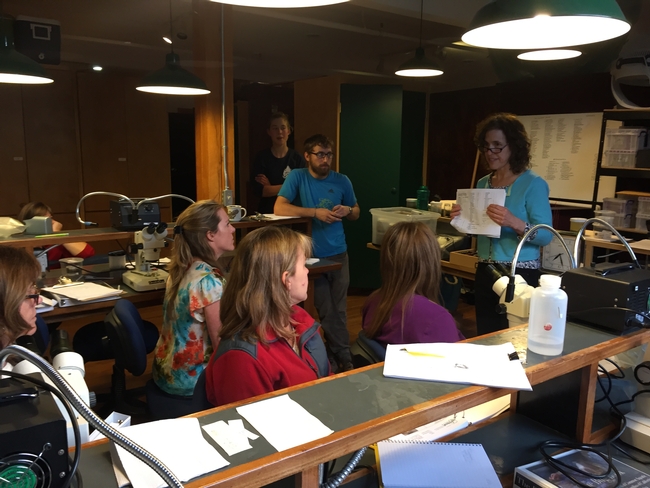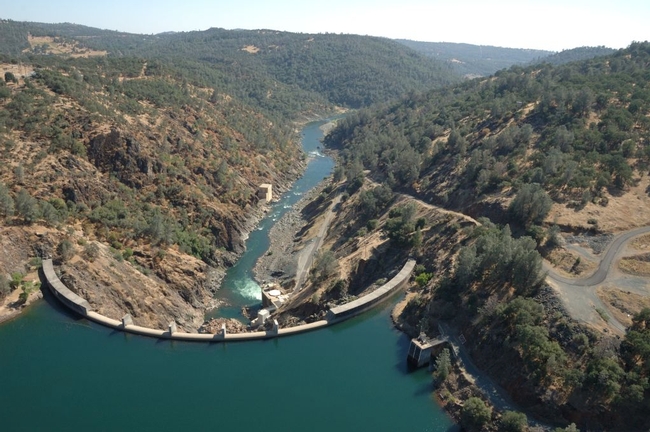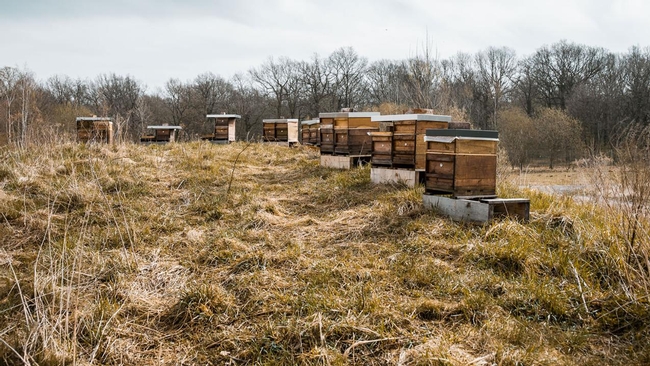
Posts Tagged: Natural Resources and Environment
Support Your Local Bee Keepers: how you can do your part
The humming sound of busy honeybees filled the fall air, darting back and forth as I followed long-time beekeeper Randy Oliver around his bee yard. I was there to learn about a new issue for local beekeepers. Oliver explained that local honeybee colonies have been robbed of their honey in places they have been kept year-after-year for several decades. Robbed?? Yes, by other honeybees, from hives from other parts of California. In the last couple years, numerous out-of-area hives have been placed in close proximity to local hives. Oliver, along with local beekeepers, presented a draft proposal to the Nevada County Ag Advisory Commission, which recommended an emergency beekeeping ordinance to county supervisors.
Oliver explained that the proposal calls for a minimum of a 2-mile radius around each existing apiary location and a 45-hive maximum in each location. All bee hives in Nevada County must be registered by the Ag Commissioner in January each year. This ordinance is designed to provide the resources and “teeth” to protect local bees and their food sources. Put in rancher terms, imagine that you had your cattle on pasture, someone saw your cattle grazing and decided to dump off 100 cows in the same pasture because it looked like a good food source. “This is beekeepers regulating themselves” said Oliver. The ordinance would not cost taxpayers and is funded by beekeepers themselves. Hobby beekeepers would be exempt from the registration fees and existing hives would be grandfathered in. Another issue with having bee colonies in close proximity is the potential for infection and mite drift into hives. Oliver explained the dangers of reintroducing a bacterial disease called American foulbrood that is nearly eradicated in Nevada County. This issue may also be of concern in Placer County.
So what does this have to do with local farmers and ranchers? If someone asks permission to put honeybee hives on your land, or leaves a note on your gate, contact your Nevada County Beekeepers Association or search “Honey” on the Placer Grown website to find local beekeepers.
A report released in March by the National Agricultural Statistics Service (NASS) stated that California produced 13,735,000 pounds of honey in 2017, worth more than $28.5 million dollars. Beekeeping is an important agricultural activity in this area. Hive rentals to almond growers rather than honey provide the major income for beekeepers, but honey is an important product in the foothills.
Learn more:
Why are honey bees important to crops and farmers? – Bees Matter
https://www.beesmatter.ca/why-are-honey-bees-important-to-crops-and-farmers/
Learn How to be a Bee-Friendly Farm - http://pollinator.org/bff
Cattle, Honey Bees Graze in Harmony on Wisconsin Farm - Find out how NRCS can help you increase pollinators on your farm or ranch. https://www.nrcs.usda.gov/wps/portal/nrcs/detail/national/home/?cid=NRCSEPRD405218
Nevada County Bee Keepers Association – http://nevadacountybeekeepers.org/
Placer Grown - http://www.placergrown.org/
Randy Oliver - http://scientificbeekeeping.com/
First national celebration for citizen science in April
Citizen science is really picking up steam with the White House honoring 12 “Champions of Change” for their dedication to increasing public engagement in science and science literacy and the recent launching of a new Citizen Science Association. This year the momentum continues and everyone will be able to celebrate the first national Citizen Science Day on April 16, 2016, when the Citizen Science Association and SciStarter will promote and inspire organizations around the country to host events in celebration of public participation in scientific research. A major celebration will be held in conjunction with the USA Science & Engineering Festival in Washington, DC. This will kick off a series of citizen science open houses and activities to be locally sponsored by science centers, museums, libraries, universities and schools, and federal agencies nationwide.
What is “citizen science” exactly? Citizen science involves engaging non-professionals in scientific research. While applied across many disciplines of science, including biochemistry, astronomy, and psychology, UC Agriculture and Natural Resources' California Naturalist Program (CalNat) specifically empowers participants and partners to use citizen science to inform natural resource management. To understand and protect natural resources, scientists and decision makers often need information over long time periods and across many locations. Citizen science is one crowd-sourced 
The CalNat Program has incorporated citizen science in the training curriculum from the program's inception. One of the program's primary goals is to increase public participation in natural resource conservation and citizen science projects throughout the state. Each partnering organization offering a CalNat certification course must adopt a class citizen science project so that each course participant gains experience in data collection and entry. Course participants are introduced to the interactive, on-line iNaturalist tool, where users can record observations from nature, develop online species lists and journals, meet other naturalists, and contribute to research-grade observations at the Global Biodiversity Information Facility. While some partner organizations already have an active 
Together, with the Alliance of Natural Resource Outreach and Service Programs (ANROSP), we anticipate celebrating the first national Citizen Science Day on April 16 with our 16 scheduled spring California Naturalist courses and the 26 other Naturalist programs around the nation.

California Naturalists contribute to a variety of citizen science projects.
UC receives PG&E land to expand research in Sierra foothills

The parcel, which is adjacent to the UC Sierra Foothill Research and Extension Center in Browns Valley, will be managed by UC to protect its natural resources. Bear Yuba Land Trust will hold the conservation easement on the Narrows property to ensure that it remains permanently protected and available for public benefit. The transaction closed today (Jan. 29).
Located on the Yuba River, the Narrows property is 60 miles northeast of Sacramento. UC Sierra Foothill Research and Extension Center has more than 5,700 acres of rangeland for scientists to study critical rangeland issues.
“We are excited to be able to manage this parcel because this new property will increase the size and connectivity between key research pastures at Sierra Foothill Research and Extension Center,” said Jeremy James, Sierra Foothill Research and Extension Center director.
Cattle grazing is a major tool to manage vegetation on rangelands and to enhance rangeland ecosystems. Although the Narrows land is too steep for grazing, it can be used to study a suite of critical natural resource processes.
“This is the first of several land transfers from PG&E to a public agency in the Yuba River watershed and the only in Yuba County,” said Marty Coleman-Hunt, Bear Yuba Land Trust executive director. “It's the culmination of over a decade of planning and work with local conservation groups and the Stewardship Council. The permanent protection of this land below Englebright Dam is critical for the health of the important Yuba River salmon fishery and public recreation for the lower Yuba River.”

The research center encompasses river, grassland, oak woodland and riparian habitat types for studying beef cattle production, nutrition and health, rangeland water quality management, oak woodland restoration, native plant conservation and invasive plant management as well as monitoring and management of sensitive fish and wildlife species.
The center has many educational features including a series of nature trails and an education center on the Yuba River, which can be used by schools and community groups for outdoor education and outreach events.
Bear Yuba Land Trust is a non-profit, membership-supported group that promotes voluntary conservation of natural, historical and agricultural resources in the Bear and Yuba watersheds of the Sierra Nevada foothills. Each year, BYLT's stewardship team will monitor the conservation easement at the Narrows for conservation values like documenting the presence of native plants and animals. BYLT will hold the development rights forever, meaning the land will be permanently protected as a natural place and remain undeveloped.
For more information about PG&E's transfer of the Narrows property, visit http://www.stewardshipcouncil.org/land_conservation/planning_units/narrows.htm.
For more information about the UC Sierra Foothill Research and Extension Center, please visit http://sfrec.ucanr.edu.
For more than 100 years, University of California Cooperative Extension researchers and educators have been drawing on local expertise to conduct agricultural, environmental, economic, youth development and nutrition research that helps California thrive. UC Cooperative Extension is part of the University of California's systemwide Division of Agriculture and Natural Resources. Learn more at ucanr.edu.
UCANR Seeks Public Comment on Proposed Livestock, Forestry and Natural Resources CE Positions By July 21, 2014
The University of California Agriculture and Natural Resources created a call in January of 2014 for new UCCE Advisor and Specialist positions. The goal for filling these positions is to strengthen and rebuild the UC ANR network to meet programmatic gaps and emerging issues facing California identified in the Strategic Vision (see: ANR Strategic Vision 2025 full report or ANR Strategic Vision 2025 Executive Summary) and further refined in each of the 5 Strategic Initiatives entitled: Endemic and Invasive Pests and Diseases, Healthy Families and Communities, Sustainable Food Systems, Sustainable Natural Ecosystems and Water Quality, Quantity and Security. All 123 new proposed positions are listed on a public web page at this link.
These proposed positions are presently undergoing internal review until August 18, 2014. The public is invited to comment on these proposed positions until July 21, 2014.
Of the 123 positions proposed, 23 positions could benefit California's livestock, forestry and natural resources based industries. Those same 23 positions would have overlapping impact on both sustainable natural ecosystems, water quality, quantity security and sustainable food systems. I have listed in the table below those 23 positions with their identifying number, title, type of position (Advisor or Specialist) and where those positions would be located. Area Advisors are housed in one county but cover multiple counties. Specialists are statewide and support Advisor research and educational programs. If you click on the ID Number it will take you to the page where you can add comments for that position. There is also a link on that same page that describes the position in more detail.
|
ID Number |
Position Title |
Advisor or Specialist |
Location, County or Campus |
|
Area Livestock & Natural Resources |
Advisor |
Tuolumne |
|
|
Area Desert Livestock |
Advisor |
Imperial |
|
|
Area Forest & Natural Resources |
Advisor |
Ventura |
|
|
Area Forest & Natural Resources |
Advisor |
Sutter-Yuba |
|
|
Area Livestock & Natural Resources |
Advisor |
Placer-Nevada |
|
|
Area Livestock & Natural Resources |
Advisor |
Sutter-Yuba |
|
|
Area Livestock & Natural Resources & Community Development |
Advisor |
Plumas |
|
|
Area Livestock & Natural Resources |
Advisor |
Ventura |
|
|
Area Natural Resources – Fire & Restoration |
Advisor |
San Diego |
|
|
Dairy |
Advisor |
Sonoma |
|
|
Dairy |
Advisor |
Humboldt |
|
|
Livestock & Natural Resources |
Advisor |
Siskiyou |
|
|
Applied Limnology (Lakes & Fresh Water) |
Specialist |
UCD |
|
|
Aquaculture |
Specialist |
UCD |
|
|
Beef Cattle Herd Health |
Specialist |
UCD Vet Med |
|
|
Dairy Cattle Production Health Management |
Specialist |
Vet Med Teaching & Research Center -Tulare |
|
|
Forest Products and Woody Biomass |
Specialist |
UCB |
|
|
Livestock & Rangeland Economist |
Specialist |
UCD |
|
|
Plant Conservation |
Specialist |
UCR |
|
|
Rangeland Management |
Specialist |
UCD |
|
|
Rangeland Policy & Planning |
Specialist |
UCB |
|
|
Rangeland Ruminant Nutritional Ecology |
Specialist |
SFREC Sierra Foothill Research & Extension Center |
|
|
Sheep & Goat Heard Health & Production |
Specialist |
UCD Vet Med |
It is very possible that not all of these positions will survive the screening process. That's why it's important to have stakeholder input and I urge you to take the time to review at least each of these and comment. Please also comment on any of the other positions shown on the full list as well.
It's also important to know that the comment process is not a voting one. Rather it is a supportive process from stakeholders who are visionary and statewide-thinking about the issues facing California's livestock and natural resources owners, managers and stewards. Some of these positions, especially the Advisors and a few of the Specialists, have had very successful people filling those slots. The public comments should not focus on replacing one of these great people but local, regional and statewide need for the position to work to solve current and future problems.
As the statewide leader for the Sustainable Natural Ecosystems Initiative, I would also like to hear from my blog readers how you might rank the positions in the above table outside of the comments you provide on the public page links I've provided in the table. To do so just either comment on this blog article, message me via LinkedIn or Facebook or drop me an email at jmharper@ucanr.edu. Please put SNESI positions in the subject so I can search and sort. I look forward to hearing from you!

